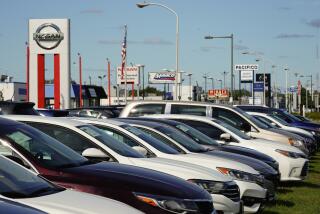Fed Study Finds Big Surge in ‘Non-Prime’ Mortgages in ’05
- Share via
WASHINGTON — U.S. mortgage lending data show sharp growth in the use of higher-priced “non-prime” mortgages for home purchases in 2005 over 2004, and even steeper gains in such loans among blacks and Latinos, a Federal Reserve study showed Friday.
The mortgage data, gathered from lenders under the Home Mortgage Disclosure Act, show that more buyers were pushed out of the most favorable loan categories as they stretched to buy homes at the height of the U.S. housing boom. Home prices in many markets peaked in the third quarter of 2005.
The Fed study showed that higher-priced first-lien mortgages, which it described as those having interest rates three percentage points over Treasury yields of comparable maturities, made up 24.6% of conventional home purchase loans on owner-occupied homes, compared with 11.5% in 2004.
Among blacks, such loans made up 54.7% of 2005 home purchase loans, compared with 32.4% in 2004. Among whites, the incidence of such loans was 17.2% in 2005, compared with 8.7% in 2004, while among Latinos, it was 46.1% in 2005 compared with 20.3% in 2004.
The incidence of such “sub-prime” and “near-prime” loans among Asians was 16.6% in 2005 compared with 5.9% in 2004, the Fed said.
Blacks also were the most likely to be denied a home purchase mortgage loan in 2005, with a denial rate of 27.5%, compared with 18% for Latinos, 15.8% for Asians and 12.3% for whites.
The study said the jump in higher-priced lending was driven partly by higher home mortgage rates, particularly for adjustable rate loans.
Loans with the same risk characteristics would have had higher interest rates in 2005 and more of them would have been categorized as non-prime under the Home Mortgage Disclosure Act.
It also said borrower-specific risks generally increased, pushing more buyers into non-prime categories.
Piggy-back lending -- the use of second-lien mortgages to allow buyers to buy homes with down payments of less than 20%, also grew substantially in 2005 and accounted for more than half the increase in the number of higher-priced loans.
More to Read
Inside the business of entertainment
The Wide Shot brings you news, analysis and insights on everything from streaming wars to production — and what it all means for the future.
You may occasionally receive promotional content from the Los Angeles Times.










